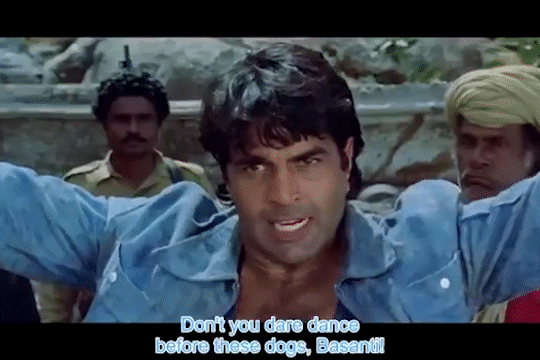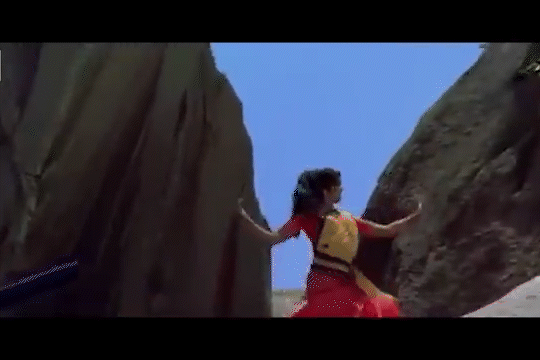“Basanti, in kutto ke saamne mat nachna!” is Veeru’s helpless plea to the love of his life Basanti. At present, Veeru, the gallant youth, has been tied up by dacoit Gabbar Singh. His lover Basanti, is being harassed by Gabbar’s cronies. With Veeru’s life at stake, Basanti makes a deal with the devil. If she doesn’t oblige, a gun pointed at the love of her life will go off. The demand? That she dances *gasp*. Her modesty at stake, Veeru vehemently protests and warns her, “Basanti, do not dance in front of these dogs.” But Gabbar is quick to remind that “As long as your feet move, he lives.”
This scene from Sholay (1975) is a rite of passage for any and all Bollywood film watchers. Sholay itself needs no introduction. The cult classic directed by Ramesh Sippy is synonymous with mainstream Hindi cinema. Within its 198 minutes of runtime, the film achieves everything that the audiences and makers of Bollywood cinema hold dear; unbreakable friendships, aspirational love stories, jaw-dropping action, action-packed dance and addictive music. Not to mention tears, melodrama and the ability to make watchers dream. Sholay’s cast featured the avengers of 80s Bollywood cinema; Amitabh Bachchan as Jai, Dharmendra as Veeru, his best friend. Veeru’s lover Basanti played by Dharmendra’s future wife Hema Malini and Jai’s lover Radha played by Bachchan’s future wife Jaya Bhaduri. The iconic Sanjeev Kumar played the arm-less Thakur while the villain Gabbar Singh was played by the inimitable Amjad Khan.
The Sholay universe combines Japan’s “samurai cinema” film genre with the stylish “dacoit western”. Though peppered with global references, the film is undeniably Indian, giving birth to India’s indigenous dacoit genre; the curry western. The name is a play on the Italian “spaghetti western” genre of dacoit/mafia films. Indian masala cinema got its presiding chairman in Sholay. It popularised the mainstream, unabashed show of escapism and unbelievable plotlines — and also the convention of using ketchup colored fluorescent fake blood. Not the finest moment in Hindi cinema history but iconic nonetheless.
As iconic as the film is, an often overlooked aspect is the backdrop of the dacoit’s lair — a stark landscape of boulder heaps, familiar to those who’ve travelled across south India, from Hampi in Karnataka to the Gingee fort in Tamil Nadu, and particularly, the outskirts of Bangalore, where the film was shot. These formations are known as inselbergs, a word derived from the German words for 'island mountain’. Inselbergs are formed by deep, slow weathering by rainwater along cracks and crevices in the bedrock. Inselbergs with their rugged appearance, rocky overhangs and the occasional cave, form the perfect dacoit hideouts. In India, inselberg landscapes have long been used by human agrarian settlements and pastoral communities, perfect for dacoits to raid and plunder! In the 90s, the inselbergs across Karnataka and Tamil Nadu, with their patchwork of mixed forests, were also the refuge of the notorious ivory and sandalwood smuggler, Veerappan!
The inselbergs form the ideal part-isolated, part-rugged backdrop for Sholay’s dacoits — a landscape that makes it difficult to find or capture these villains. This landscape also sets the stage for two incredible dance sequences. In Helen’s seductive dance, the flickering fire casts shadows on the rocks, behind which our intrepid heroes ready themselves for an ambush. For Hema Malini’s dance of desperation, the landscape is a sun-baked surface, with threatening gun-toting dacoits perched on crags, watching the spectacle below.
The most remade song of the two features the queen of cabaret, Helen. Mehbooba Mehbooba, choreographed by P.L. Raj, is an item song in the truest sense. It features Helen dancing for the dacoit gang for entertainment. The atmosphere is one of celebration — bonfires are on, bare hips are out. On one side, Gabbar leans on a cot watching Helen’s moves. On the other side, Helen is surrounded by her colourfully dressed musicians. In the backdrop, we see tents, smoke rising and of course, the inselberg formations. These imposing rocks create a space of familiarity and comfort. The space where Helen is dancing feels small, intimate and warm (due to the bonfire, of course, and Gabbar’s constantly oily skin.)
It is important to note how Helen is simply the dancing girl here, she never sings her own song. This creates a distinction in the mind of the viewer who now looks at the dancing girl merely for what her body is doing and not what her mind thinks. Helen’s hips, rumoured to be on rollers, do not disappoint. That’s the reason she became the queen of cabarets and as an article notes, it is choreographer P.L. Raj who enabled that title with his creative movements.
On one hand, the proximity of the formations creates an air of intimacy, on the other hand, they cause suffocation. Basanti’s dizzying moves in Haa Jab Tak Hai Jaan – her dance to save Veeru’s life is the perfect example. With a rifle pointed at her lover, she begins to move. The bouncy rhythm of the song makes most of the choreography staccato and gives Hema Malini the right movements in which to show her quiet determination — a brain wave by choreographer P.L. Raj. She hardly smiles in this song, an unusual choice for an “item number,” but the right choice for the context. Here the situation demands from the actress a sort of reserved yet ambitious, angered expression. Hema Malini’s background in classical dance is integrated into the choreography as she performs movements from the Bharatanatyam repertoire.
The lyrics by Anand Bakshi carry the determination of undying love of which this dance is a result. “Pyaar kabhi bhi marta nahi / Maut se bhi darta nahi,” love never dies, it is not even afraid of death. The way this one line is picturised in the song brings to light what is really special about this number — directionality. The inselberg formations don’t just form a backdrop to this song, it forms the very structure of the set. Gabbar’s hideout, where this song takes place, is surrounded by these rocks and therefore creates the illusion of a secluded, confined place. It is in this space that Basanti dances. Imagine a stage surrounded by an audience on all sides – a 360-degree structure. This would demand from the dancer and the choreographer the ability to change the direction in which they dance.
Whichever direction she turns to, she is met with a threat. There is Veeru hopelessly tied up, there is the gun pointed at him, there is Gabbar watching the show and his cronies everywhere else. The circularity in the space gets reflected in the dance and the cinematography. Where on one end she runs to Veeru singing to him that love never dies, once she turns around, she is met with the mouth of the gun as she announces that love is not afraid of death. The cinematography and editing enhances this feeling of being trapped by cutting to inserts of every one’s reactions to her song and dance. These close ups make the space feel suffocating. Her only respite is to run to the rocks–and even those are too large to conquer. In an incredibly effective shot, the camera is kept at a lower angle, pointed upwards towards Hemamalini’s face. She spins as the camera follows her and even from this extreme perspective all we see around her are the inselbergs. The suffocation reaches its max when we realise, it is not just the rocks and the people, but even the sunshine is oppressing this dancing girl.
As Basanti dances, she keeps looking up at the sun. The sun is sucking every ounce of energy out of her. As if dancing for unruly, dog-like men wasn’t enough, she is dehydrated while doing it. Surrounded by men, huge rocks, and now the hot, blazing sun, Basanti dances as death hangs over her shoulder. At one point, Gabbar urges his crew to toss glass bottles that shatter upon the rocks, yet the dance continues.
This is in stark contrast to another dance song shot in this same location.
Helen is dressed in a sparkly green outfit which sits in stark contrast to the brown of the sand and the grey of the rocks. It also contrasts Hema Malini’s sober looking orange outfit in her song. The colours of both their costumes make them stand out amongst the scenery which mostly includes shabbily dressed dacoits, humongous dark grey rocks and a bluish sky. However, the dance, its picturisation and the lyrics make the same space look so very different. The cinematography in both songs brings out a mesmerising difference in the use of this backdrop.
In a sense, an inselberg is a residual feature - one that persists in a landscape long after its contemporaries have eroded away. As dance sequences go, Sholay’s iconic choreography has also persisted in the memory of film lovers and dance enthusiasts, long after its time.
This article was written in collaboration with Devayani Khare. Devayani is a geographer with a passion for telling deep-time stories about the landscapes around us. She believes landscapes are about memories - those captured in or imprinted upon rocks, the genetic legacy of biodiversity, and the echoes of human history. Through her newsletter, Geosophy, she hopes to capture and convey this ‘persistence of memory’.
Video Sources: YouTube/NH Studioz, YouTube/NH Hindi Songs









